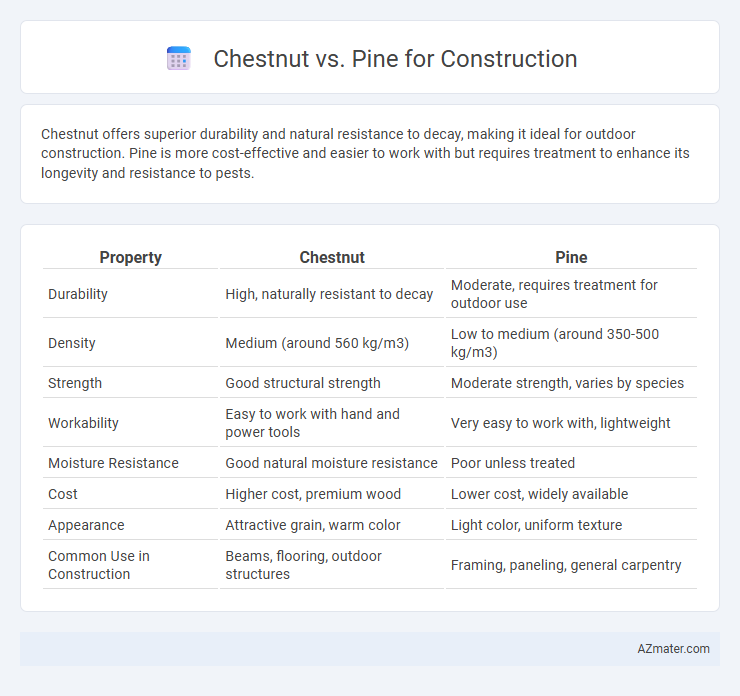Chestnut offers superior durability and natural resistance to decay, making it ideal for outdoor construction. Pine is more cost-effective and easier to work with but requires treatment to enhance its longevity and resistance to pests.
Table of Comparison
| Property | Chestnut | Pine |
|---|---|---|
| Durability | High, naturally resistant to decay | Moderate, requires treatment for outdoor use |
| Density | Medium (around 560 kg/m3) | Low to medium (around 350-500 kg/m3) |
| Strength | Good structural strength | Moderate strength, varies by species |
| Workability | Easy to work with hand and power tools | Very easy to work with, lightweight |
| Moisture Resistance | Good natural moisture resistance | Poor unless treated |
| Cost | Higher cost, premium wood | Lower cost, widely available |
| Appearance | Attractive grain, warm color | Light color, uniform texture |
| Common Use in Construction | Beams, flooring, outdoor structures | Framing, paneling, general carpentry |
Chestnut vs Pine: An Overview
Chestnut and pine are popular timber choices in construction due to their distinct properties and applications. Chestnut wood is valued for its durability, resistance to decay, and attractive grain, making it ideal for outdoor structures and fine woodworking. Pine, while generally softer and less durable, offers affordability, ease of workability, and rapid growth, making it suitable for framing and interior applications.
Wood Properties and Strength Comparison
Chestnut wood offers moderate strength with good durability and resistance to decay, making it suitable for outdoor construction and furniture. Pine is softer and less dense but has excellent workability and fast growth rates, commonly used for framing and interior applications. Both woods have distinct grain patterns and moisture resistance levels, with chestnut typically providing superior longevity compared to pine.
Durability and Resistance to Decay
Chestnut wood is renowned for its exceptional durability and natural resistance to decay, making it an ideal choice for outdoor construction and joinery. Pine, while more readily available and cost-effective, generally has lower resistance to rot and insect damage, requiring treatment for long-term structural use. The high tannin content in chestnut contributes significantly to its decay resistance, outperforming pine in longevity and maintenance needs in harsh environments.
Workability and Ease of Use
Chestnut wood offers superior workability with its fine, straight grain and softness, making it easier to cut, shape, and nail compared to pine. Pine, while also workable, tends to be softer and more prone to dents and scratches, requiring more careful handling during construction. Both woods are suitable, but chestnut's balanced hardness and smooth texture provide a more precise and durable finish for intricate woodworking projects.
Cost and Availability Factors
Chestnut wood, known for its durability and resistance to decay, tends to be more expensive than pine due to limited availability and slower growth rates. Pine is widely available and grows quickly, making it a cost-effective choice for construction projects with budget constraints. The higher initial cost of chestnut can be offset by its longer lifespan, while pine requires more frequent maintenance or replacement, affecting long-term expenses.
Environmental Impact and Sustainability
Chestnut wood is a sustainable construction material due to its fast growth rate and natural resistance to pests, reducing the need for chemical treatments. Pine, widely used in construction, grows quickly but often requires heavy chemical preservatives to enhance durability, which can negatively affect the environment. Choosing chestnut over pine can lower chemical use and promote eco-friendly building practices in sustainable construction projects.
Aesthetic Differences in Appearance
Chestnut wood features a rich, warm hue with prominent grain patterns that provide a luxurious and rustic aesthetic ideal for traditional construction styles. Pine offers a lighter, pale yellow tone with subtle knots and a smoother grain that suits modern, minimalist designs and can be easily stained for various finishes. The distinct color contrast and texture of chestnut versus the uniformity of pine influence the overall visual impact of architectural elements and interior woodwork.
Applications in Modern Construction
Chestnut offers superior durability and resistance to decay, making it ideal for structural elements such as beams and flooring in modern construction. Pine, valued for its affordability and ease of workability, is commonly used for framing, paneling, and interior trim work. Both woods contribute distinct aesthetic qualities and functional benefits, influencing their selection based on project requirements and environmental conditions.
Maintenance and Longevity
Chestnut wood offers superior natural resistance to decay and insect damage, reducing maintenance requirements compared to pine. Pine requires regular treatment with preservatives and protective coatings to prevent rot and pest infestations, increasing ongoing maintenance efforts. In terms of longevity, chestnut typically lasts several decades longer than pine when exposed to outdoor conditions, making it a more durable choice for long-term construction projects.
Choosing the Right Wood: Chestnut or Pine?
Chestnut offers exceptional durability and natural resistance to decay, making it ideal for structural elements exposed to moisture, while pine is softer and easier to work with but less resistant to wear and insects. Pine's lighter weight and affordability suit interior framing and decorative purposes where cost-efficiency and ease of handling are priorities. Selecting chestnut over pine enhances longevity and strength in outdoor or heavy-load applications, whereas pine remains a practical choice for budget-conscious projects with less demanding environmental conditions.

Infographic: Chestnut vs Pine for Construction
 azmater.com
azmater.com